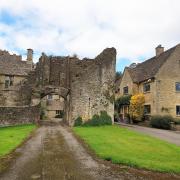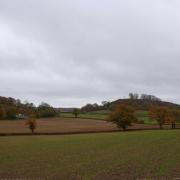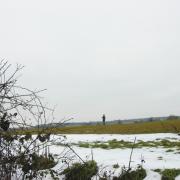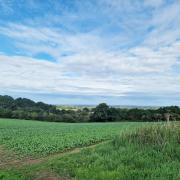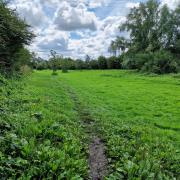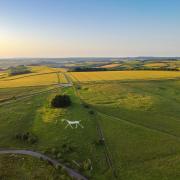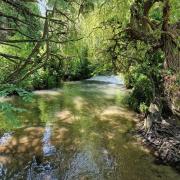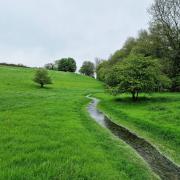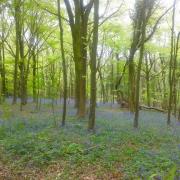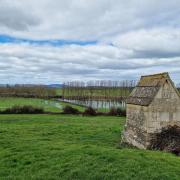A walk and reflection amidst the beautiful woods, fields, and buildings of Miserden.
In a lovely Cotswold village like Miserden, there’s a marvellous sense of harmony in the geometry of the stone buildings, and of balance between the buildings and the land. In the surrounding landscape there’s a harmony, too, between woodland, wetland, and shapely open country. Such beauty and tranquillity should not be taken for granted. Things are always changing, peace and even life itself can be fragile, so history reminds us.

If stones could speak, Miserden Church would have some have some stories to tell. It’s been there since before the Norman Conquest, at least the oldest parts of it, such as the Romanesque arch above the north door. They call this door the Devil’s Door; it’s said to be used by the souls of the dead as they leave the church to make their final journey. Outside that door stands a big yew tree, the shade of whose dark poisonous branches you can imagine as a way between the worlds. In the graveyard beyond, a number of fresh graves brought to our minds the ongoing pandemic and all the changes it is bringing.
Opposite the church stands the monument to the fallen of the world wars, a short-armed cross designed by the renowned early 20th-century architect Sir Edwin Landseer Lutyens, who had recently done work at Misarden Park. But a relic of far more ancient wars lurks in the woods down by the River Frome. To get there, walk along the road from the church into the village and, at the central tree, ringed by sheltered benches, bear left past Miserden House, and then left again down a private road that coincides with the public right of way. Where this road bends sharply left, head to the right, across the grass, to a stone-slab stile that takes you on to a path through the woods. Turn right when you come to a junction of tracks, and very soon on your left you’ll encounter the remains of Miserden Castle.

After the passage of years, you might think this complex of overgrown earthworks was a prehistoric hill fort, but it was in fact a motte and bailey castle built in the 12th century by Robert Musard. The deep encircling ditch once contained a moat, probably replenished by the meander of the river looping around the site. At the top of the central mound the surviving masonry is buried in vegetation. It’s strange to imagine that a Norman keep once rose through the space now filled with trees. If you came here after dark, might you hear the sounds of lords and ladies feasting and the music of their minstrels?
Musard was one of the lords of the West who took the side of Empress Matilda in her struggle to wrest the crown of England from her cousin King Stephen. This 12th-century civil war is known to history as ‘The Anarchy’. The lust for power of the two claimants to the throne tore the country apart in a catastrophe of brutality and devastation that dragged on for nearly twenty years. The story goes that Musard was ambushed by Stephen’s men and killed. His castle remained in use through the recurring civil wars of the 13th century, but was abandoned before the century’s end and finally destroyed during the Wars of the Roses in the century after that.
Today this military installation has become a space for nature, a diversity of microhabitats conjured by the complexity of the terrain. The living world has grown back, as it always will, eventually, when given half a chance. Coming here in winter, we enjoyed the birdsong in the treetops and the emerald green of the moss, the yellows and russets of dead leaves, the dark green of ferns on the ditch walls, the pale grey of the winter sky and its reflection in the lake downstream. Perhaps the spirits of warriors have by now been replaced by the spirits of nature.

Descending southwest from the castle, you can join a tarmacked track that leads down to the west side of Misarden Park Lake. As you cross the weir at the end of the lake, there’s a fantastic view back across the water. When we were there, the trees and the clouds were so perfectly reflected that you could make out as much detail in the reflections below as in the scenery above, and we felt a sense of vertigo looking down into the depths of the sky. How could you tell which was the more real? The Tibetan sage Longchenpa taught awareness of maya, the shifting appearance of reality, through contemplation of the world as dream, as magic show, as optical illusion, as mirage, as echo, as celestial city, as apparition, and as reflection in water. In this way, the teaching goes, you can experience an enlivening sense of enchantment in everything as it keeps transforming around you.
Where the path starts to go uphill, turn right on to a permissive path along the east bank of the Frome and a second, more swamplike lake. A vista of beautiful wild parkland rises on your left. At the end of the permissive path a locked gate has to be climbed to reach the road. Turn right along this lane, ignoring the footpath directly opposite, then take the next footpath to the left, heading uphill. After passing through a gallery of trees you come to a junction of paths in the corner of a field. Turn right and then keep going straight ahead. On your right you’ll pass the trim flat-topped wall of the grounds of Misarden Park, where an apparition of a white lady in a carriage is often seen. Who she might be we haven’t found out, but the fact the manor of Miserden was part of the marriage portion of all of Henry VIII’s wives suggests some possibilities.
If it’s safe, virus-wise, by the time you do this walk, you can stop for some refreshment at the Carpenter’s Arms, just across the road to the left. The folklorist Roy Palmer says that in this pub, in living memory, people used to sing The Song of the Thrush. The lyrics of this song tell of a mining camp in the Australian bush, where a young man from England arrived with a song thrush in a cage. The miners flocked round in their thousands to listen to the bird trill its song. Their eyes filled with tears as the sound brought back memories of the English countryside that lay thousands of miles away, to which perhaps they would never have chance to return.

COMPASS POINTS
Distance: 3¼ miles.
Duration: 2.5 hours.
Level: Moderately easy walking, but sometimes no physical path on the ground. The ascent of Miserden Castle is steep and slippery but can easily be omitted from the route.
Parking: At weekends you can use the school car park. Otherwise, road parking.
Toilets and refreshments: The Carpenter’s Arms; the Garden Cafe.
Transport links: Limited bus service between Stroud and Painswick, No. 228.
Map: OS Explorer 179: Gloucester, Cheltenham & Stroud.
MOBILE PHONE WALK AROUND MISERDEN
Start: Miserden
Distance: 4.5 miles (7.2km)
Time: Approx. 2.5 hours
Parking: Roadside
Recommended direction is anticlockwise
The pretty, almost hidden village of Miserden is surrounded by exceptionally beautiful countryside mostly belonging to, and very well maintained by, the Miserden Estate. Throughout this walk around the estate, there are wonderful views to admire at every turn. Its ‘off the beaten track’ route means you can enjoy total peace and quiet with only the sound of birds.
The village itself is totally unspoilt and has pretty Cotswold stone cottages, a beautiful church and a small shop. For refreshments after your walk, there is the delightful Carpenters Arms, a 16th-century pub, or The Garden Cafe which is in the Miserden Gardens.
Download the Cotswold Walks app and let your mobile guide you around the route. It shows your location on the map as you walk, and even works without a phone signal.
To download the app, search ‘Cotswold Walks’ on the iPhone or Google Play AppStore. For more information visit localwalks.co.uk






